FEATURED 3D PROJECT: RUTOPIA 2. DEVELOPMENT OF A VIRTUAL REALITY ARTWORK by Daria Tsoupikova, University of Illinois at Chicago, USA
Keywords: Rutopia 2, art, Virtual Reality (VR), CAVE®, networks, tele-immersion.
Abstract
The virtual reality art project Rutopia 2, a follow up to Rutopia, explores the relationship between the aesthetics of virtual art, painting and Russian folk arts. The project depicts a magic garden with interactive sculptural trees that serve as portals to remote worlds. Inspired by folk utopian idealism and futuristic design, the garden is a visualisation of an unattainable world of harmony, inspired by folk utopian idealism and futuristic design. It is also a place where the symbiosis between man, nature and technology may be explored interactively.
Rutopia 2 was designed for exhibitions on the CAVE and C-Wall virtual reality display systems. It was created using the Ygdrasil (YG) framework, which was developed as a tool for creating networked virtual environments. Rutopia 2 utilises advanced rendering techniques recently added to the Ygdrasil framework. This paper reviews the methodology of project development and examines its realisation from hand-painted sketches to implementation in the real-time, interactive 3D environment.
Virtual Reality and the CAVE
Virtual Reality technology offers the chance to merge realism and imagination in the creation of evolutionary, fully-embodied and interactive experiences, thus transforming media, culture and the world. Powered by the continuing electronic, telecommunications and global networking revolution of the past years, Virtual Reality explores the interplay between technology and the human sensory/aesthetic experience. The development of VR art blends a wide range of fields such as art, design, science, technology, research and collaboration. Exhibitions of the art of VR as a visual medium have continued over the past ten years in conferences and festivals such as ACM SIGGRAPH and Ars Electronica. The success of VR projects during the numerous stand-alone and networked exhibitions encourages future national and international research in this area.
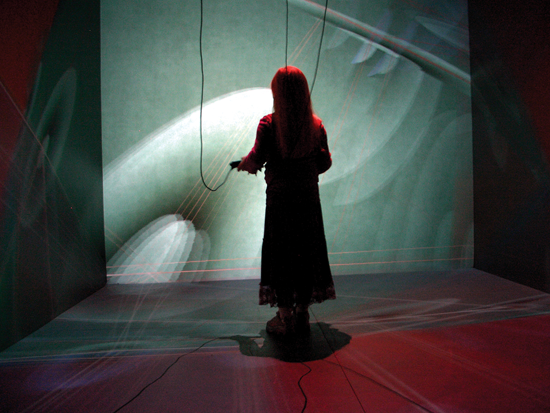
Fig. 1. CAVE virtual theatre. Image provided by Julieta Aguilera, Electronic Visualization Laboratory, University of Illinois at Chicago. Reproduced with kind permission.
The creation of Virtual Reality artwork started in the late 1980s with the advancement of VR technology and display systems. It flourished in the 1990s after the invention of the Automatic Virtual Reality Environment (CAVE) system at the Electronic Visualization Laboratory (EVL), University of Illinois at Chicago (UIC) in 1992. The CAVE is a VR theatre shaped as a cube (Fig. 1). The walls of its room are composed of rear-projection display screens and the floor is made of a down-projection screen. High-resolution projectors display 3D imagery on each of the screens by projecting it onto rear (walls) and upper (floor) mirrors that reflect the imagery onto the screens. Inside, the CAVE participants wear stereo glasses and can navigate in the VR environment and interacting with the 3D graphics. The user is tracked from the stereo glasses and the hand Wanda™ tracker. Participants inside the CAVE can walk around 3D objects and interact with them in real time. When a user walks around in the CAVE, his movements are being tracked with the electromagnetic sensors as the 3D environment adjusts to the user’s perspective. The Single Wall Automatic Virtual Environment projection system (C-Wall) is a high-quality, tracked, circularly polarised, passive, stereo wall for VR projection. It is a site-specific, configurable installation with a desktop PC using a fast graphics card, two projectors, tracking system and a polarised screen. It functions as a one-wall CAVE.
Rutopia 2 was designed for the exhibition on the CAVE and C-Wall VR systems (Fig. 2). A participant in the C-Wall presentation can interact with the project and navigate in the environment. The user's position in the virtual world is tracked from the glasses and wand trackers. When a person navigates and interacts with the virtual environment, messages are sent to the system and information is then streamed back into the C-Wall in real time.
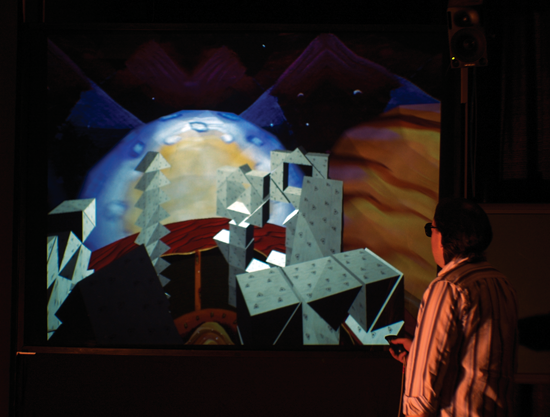
Fig. 2. The user navigates Rutopia 2 on the C-Wall. © Daria Tsoupikova. Reproduced with kind permission.
VR Development and Implementation
Virtual Reality development requires not only artistic talent but also diligence, the courage to take entrepreneurial risk, and the fortitude to persevere with original ideas. One needs not only to be able to solve time-consuming technical problems, but also have excellent communication and problem solving skills, while maintaining a high level of creativity. Virtual Reality artists are responsible for all aspects of conceptualisation, design, development, computer graphics, programming, 3D modelling, animation, navigation, sound, interactivity as well as testing, optimisation and performance during the presentations at the VR exhibitions and tele-immersive events (see section Network, below, for details).
The development of the virtual artwork in Ygdrasil is based on latest achievements in computer graphics techniques and typically requires the following implementation steps:
- Conceptualisation,
- Sketches, storyboards and scene graphs of the virtual space;
- Design and development of the 3D models and objects;
- Design and development of the textures;
- Design and programming of the virtual environment and its scenery;
- Design and development of interactivity, objects behaviours, and user experience
(presence and navigation) inside the VR environment;
- Programming and implementation of the interactivity;
- Development and implementation of the animation and special effects;
- Implementation of the sound;
- Development of the networked version;
- Testing and evaluation;
- Postproduction and optimisation for the final output for stereoscopic display systems.
Concept
The research and artwork in Rutopia 2 explores the relationship between the aesthetics of virtual environments, traditional arts and the effect of VR aesthetics on the user's perception and emotions. It examines how traditional art principles, such as balance, colour, repetition and rhythm, can enhance the navigation and interactivity in real-time, digital 3D environments. The quality of the graphics and the aesthetics of the virtual world can influence exploration, guide the user and enhance sensual experience in a virtual environment. The goal of the VR artwork is to capitalise on the immersive power of the new technology and aesthetics to create a visual interaction that morphs into a unique virtual experience.
Rutopia 2 describes a magical garden with interactive sculptural trees. It was conceived as a virtual environment linked to a matrix of several other unique virtual environments that together create a shared network community. The 3D modular sculptural trees, each consisting of dozens of rectangular screens, serve as portals to the other interconnected environments. The animation of these dynamic, tiled trees is an attempt to break through the static flatness of the contemporary tiled-display grids, architectural facades, and surfaces into the perpetually changing 3D sculptural forms of the ubiquitous public network. The trees are the prototypes of the interdisciplinary public portals that combine architectural, tele-immersive, educational and artistic ideas with social functionality into a communal hybrid. Their organic movements, embodied through mathematical calculations and interpolations, depend on the user's interaction with the environment and his or her proximity to the trees.
When visitors enter the virtual space, they see a gray, monochrome world with a small island surrounded by a river. Visitors can use one of the two bridges across the river to enter the island. The island has three interactive areas in which the user can grow the trees by simply approaching them. Each tree appears as a rapid sequence of flipping and rotating rectangular screens. Those screens finally stick together in the shape of a tree. Once the trees are fully grown, the screens convert to the portals that link to remote worlds. Each window shows the view of the remote environment connected to it. The island mode changes from the grayscale to multicoloured. Visitors can look through the screens to see distant environments just like one can look through a window and see the outside. The high resolution details of the remote worlds are depicted on the screens of the trees. By moving his or her head through one of the virtual screens, the user enters the connected environment. Visitors can explore the remote spaces consisting of imagery found in Russian fairytales and folk art (Fig. 3).

Fig. 3. Screenshots of the virtual environment of Rutopia 2. The visitor is looking through the screens to see the remote world. © Daria Tsoupikova. Reproduced with kind permission.
Sketches
Rutopia 2 started with sketches of the networked virtual spaces (Fig. 4). The initial idea for the project was to create a matrix of virtual spaces enabling real-time relocation. Each unique space is connected to a portal, the 3D sculptural tree, which is built from a singular module - a rectangular screen. Each screen shows the view of the remote space connected to it. Visitors can look through the screen to see the details of the remote space and by moving head through the screen they can enter that space.
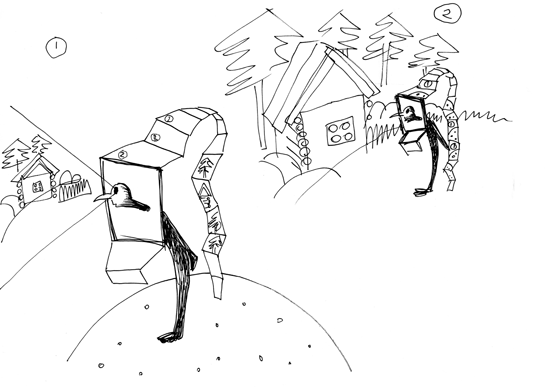
Fig. 4. Rutopia 2. The initial sketch for the network and interaction. By moving one's head through the screen in the tree in the space 1 the user enters the remote space 2 in real time. © Daria Tsoupikova. Reproduced with kind permission.
Aesthetics and Influences
The project was inspired by Russian folk arts and crafts, specifically the painted miniatures of Palekh, the toys of Dymkovo and the painting technique of the Khokhloma. Each of these Russian styles was developed in a specific area, which dictated the ornamental patterns, colour palette, and choice of materials. These craft objects were sold at country fairs and were often inspired by pagan gods and mythological characters. Dymkovo toys have very simple rounded shapes and silhouettes. They are painted in bright ornamental patterns with brilliant magenta, green, yellow and blue against a white background. Palekh craftsmen succeeded in evolving a highly original painting style, making expert use of the decorative black background, gracefully shaped expressive figures, sophisticated colour schemes, and refined ornamental patterns.1 The Khokhloma painting style is recognised for the golden background, where this effect is achieved without gold being used. The aesthetics of Rutopia 2 are based on the principles of composition that rely on bright colours and simplified, contoured shapes inspired by these styles. Traditional aesthetics give this virtual world a magic-like atmosphere communicating harmony and balance to affect the emotional experience while maintaining aesthetic principles of previous centuries. The aim was to study how these aesthetics can be used for improving intuitive navigation and interaction in virtual space.
3D Models and Textures
The 3D objects were first visualised during the conceptualisation phase in the hand-painted storyboards using gouache and watercolour. They were painted with consideration of the future development and interaction techniques. The original storyboards are the models for the final virtual spaces with the exception of several details. All elements of the future virtual space such as the trees, house, island, and bridges were first designed and planned on these storyboard sketches. They set up the composition, colour palette, virtual space layout and served as references for the development of the scene graph and interactivity (Fig. 5).
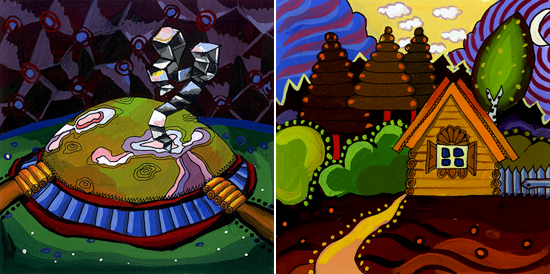
Fig. 5. Rutopia 2. Hand-painted storyboards. © Daria Tsoupikova. Reproduced with kind permission.
All 3D elements, objects and textures in the project were first hand-painted in a variety of details and sizes on paper using gouache colours. The 3D models based on the storyboard visuals were built using 3D Paint tool in the Autodesk Maya package (Figs. 6 and 7). Maya software provides various techniques for creating unique painted textures for models such as real time 3D/2D painting and 3D texture synthesis inside the 3D scene. These techniques enabled smooth integration between initial storyboard sketches, the development stage, and the final design of Rutopia 2. The details of the decorative ornamentation were painted inside the 3D scene and then exported as models with textures. Other textures were painted individually, scanned, and applied to the 3D objects.
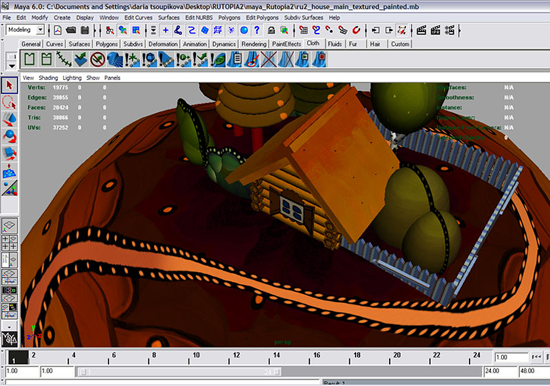
Fig. 6. Rutopia 2. Development of textures using 3D Paint tool in Maya software (work in progress). © Daria Tsoupikova. Reproduced with kind permission.
Technical Realisation Using Advanced Rendering Techniques of Ygdrasil
Rutopia 2 was created using Ygdrasil (YG) framework, developed as a tool for creating networked virtual environments by EVL's Dave Pape.2 It is focused on building the behaviour of virtual objects from reusable components, and on sharing the state of an environment through a distributed scene graph mechanism. The scene graph is a framework structure that organises objects, nodes, and behaviours. Ygdrasil includes a number of nodes that implement common virtual world components, such as transformations, sounds, user avatars, navigation controls, timers and triggers that detect when a user enters an area. Ygdrasil is being used in the design of artistic and educational virtual reality applications. The framework initially required specialised C++ knowledge to develop special purpose modules for all but the most basic projects. Recent improvements to the Ygdrasil framework by EVL's Alex Hill allow artists to create advanced virtual worlds with minimal technical assistance.3 These improvements to the scripting language and high-end rendering technique modules helped to create the enriched dynamics and content of the Rutopia 2 art project.
The windows of the trees were made using the new stencilBuffer node.4 This node acts as a mask covering the areas outside the windows so that only the selected window area allows a view to the other world. The other world consists of two objects, the rendered object and the stencil object. The rendered object is the geometry of the remote place which the user can see through the window. The stencil object forms the viewing window and is used by the stencilBuffer mask so that the user can see only a portion of the rendered object through the region defined by the stencil object. Each third window-hole on a tree is connected to the same view of the remote world in an alternating fashion. Participants can recognise and visually connect lower and upper parts of the remote world projected on the different level windows to appreciate an even broader view of the remote environment.
The navigation and interaction of Rutopia 2 is based on the participant’s proximity to responding objects and interactive areas. The wand interface is used only to control the direction of the movement. The negation of the buttons in the wand interface forces intuitive navigation in the virtual world. The goal is to avoid the preliminary instructions usually required to familiarise the user with the virtual environment and its rules of exploration.
The project was built using Ygdrasil advanced rendering techniques, Bergen spatial sound server, OpenGL Performer 3.2 and the CAVE library. It runs on an Intel Linux PC running SUSE 10.0 and connected to an Ascension Flock of Birds tracker.
Network
With the development of high-speed networks in the mid 1990s interactive Virtual Reality artworks and virtual environments could be shared and explored over the network across remote CAVE sites. In these tele-immersive exhibitions remote participants from international and national locations interact with each other in the virtual environments in real time. The participants see each other as avatars in the virtual environment. Since the participants are wearing tracking systems they can see where each other’s avatars are looking and pointing as well as navigating. Artists and participants can share ideas, discuss their performance and collaboratively create and explore virtual worlds. Space and time can be manipulated interactively and remotely through the network while participants share common sensational experiences. However, testing and optimisation work, both locally and over the network, that is required for the successful network presentation, is extremely elaborate and time-consuming.
Tele-immersive art shows have expanded to super high-resolution presentations and telematic performance art events across advanced global research networks such as CAVEwave/National Lambda Rail, SurfNet and GLORIAD. The research to develop and refine advanced VR display systems, hardware and software for building tele-immersive applications continues, allowing audiences an unprecedented quality of experience across long distances using advanced networks.
The first tele-immersive demonstration of Rutopia 2 in 2005 established network collaboration between Moscow, Amsterdam, Chicago and San Diego. It was held at the IGRID Conference, Calit2, University of California, San Diego in collaboration with the Geophysical Centre of the Russian Academy of Sciences (GC RAS), Moscow, Russia. The C-Wall system was used at the conference site while the Moscow team used the CAVE simulator mode (non stereoscopic real time interactive 3D model of the CAVE simulator). The network used CAVEwave/National Lambda Rail connection between San Diego and Chicago sites; SurfNet connection between Chicago and Amsterdam sites; and GLORIAD connection between Amsterdam and Moscow sites. Skype was used for audio communication between remote avatars throughout the network. During the networked demonstrations the project showed three interconnected worlds: the island world, panoramic garden and the house world.
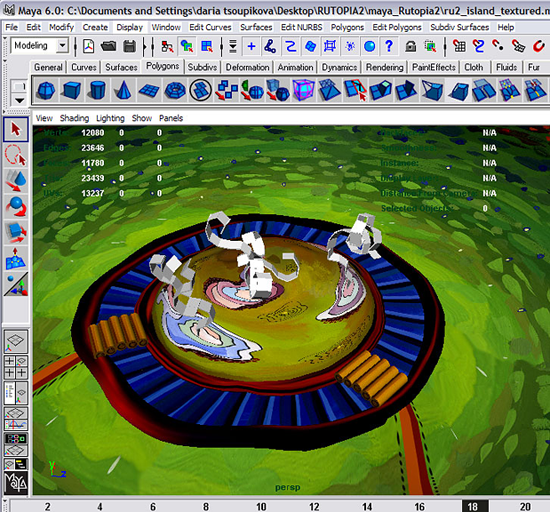
Fig. 7. Rutopia 2. Development of textures using 3D Paint tool in Maya software (work in progress). © Daria Tsoupikova. Reproduced with kind permission.
Further Information
The development of VR environments is interdisciplinary in nature and requires variety of skills. The Yigdrasil framework used in the development of Rutopia 2 is an open source framework. Its documentation, installation guidelines and examples are available on the website of the University of Illinois at Chicago's Electronic Visualization Laboratory, EVL.
See also the Rutopia 2 website and 3DVisA Index of 3D Projects
Acknowledgements
Alex Hill for technical expertise and constant support.
Kathrine Kim and Kat Mui for editorial support.
The support of the University of Illinois at Chicago's Electronic Visualization Laboratory (EVL), Geophysical Center Russian Academy of Sciences (GC RAS), Global Ring Network for Advanced Applications Development (GLORIAD) and San Diego State University.
This material is based in part upon EVL work supported by the National Science Foundation (NSF), notably equipment awards CNS-0224306 and CNS-0420477 and international networking infrastructure awards OCI-0229642 and OCI-0441094. The CAVE®, CAVElibTM and WandaTM are registered trademarks of the Board of Trustees of the University of Illinois.
Notes:
1. Ovsiannikov, I. (1967), Russian Folk Arts and Crafts. Moscow, Progress Publishers.
2. Pape, D., Anstey, J., Dolinsky, M. and Dambik, E. (2002), 'Ygdrasil - a framework for compositing shared virtual worlds', Future Generation Computer Systems, Special Issue IGRID 2002, pp. 1041-1049. For more information about the Ygdrasil framework see the EVL website, which includes documentation and downloads.
3. Tsoupikova, D., Hill, A. (2007), 'Development of Rutopia 2 VR Artwork Using New Ygdrasil Features', GRAPP 2007, International Conference on Computer Graphics Theory and Applications, Barcelona, Spain, 8-11 March 2007, Proceedings published by INSTICC Press, Portugal, pp. 225-228.
4. Op.cit.
© 3DVisA and Daria Tsoupikova, 2008.
Back to contents
